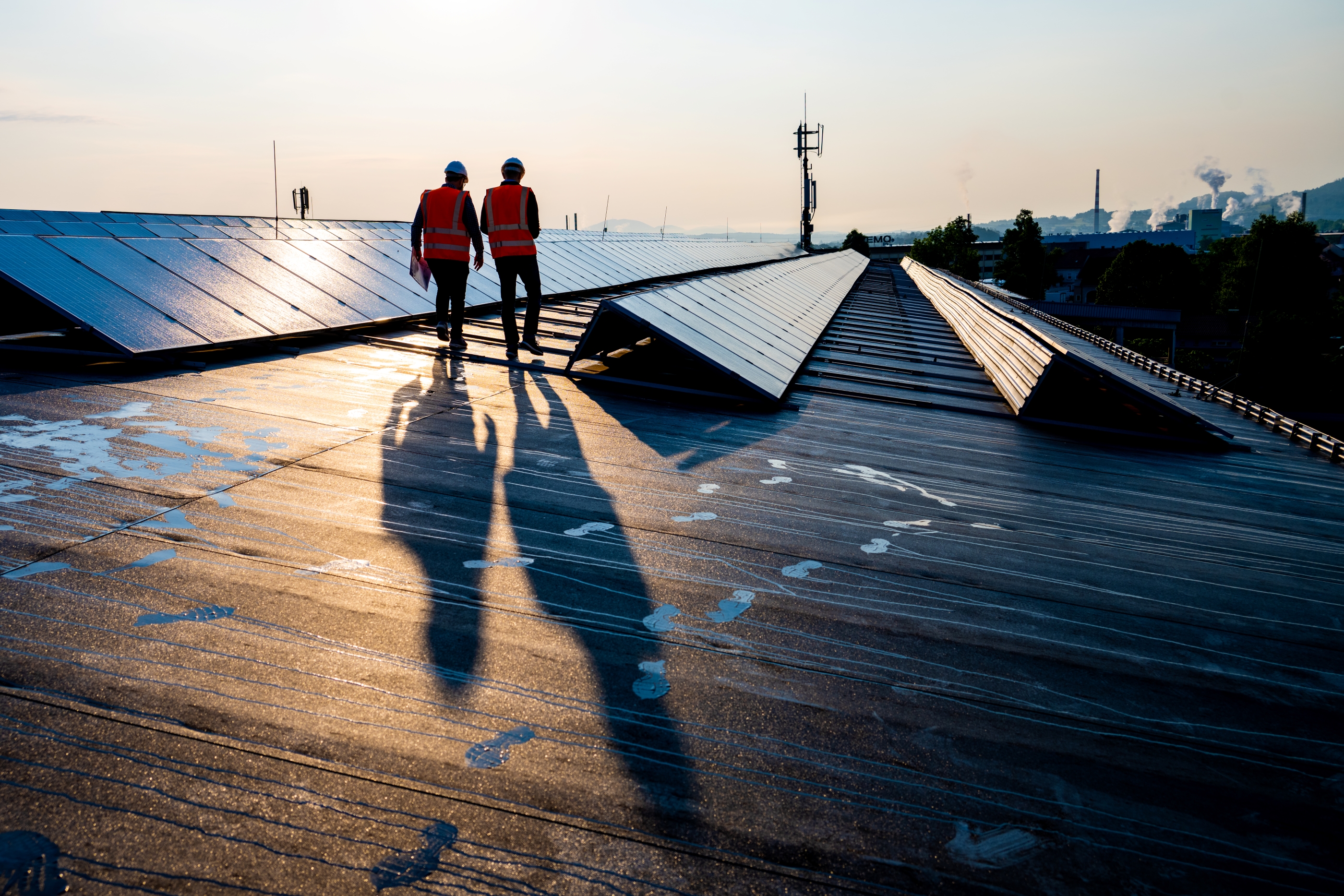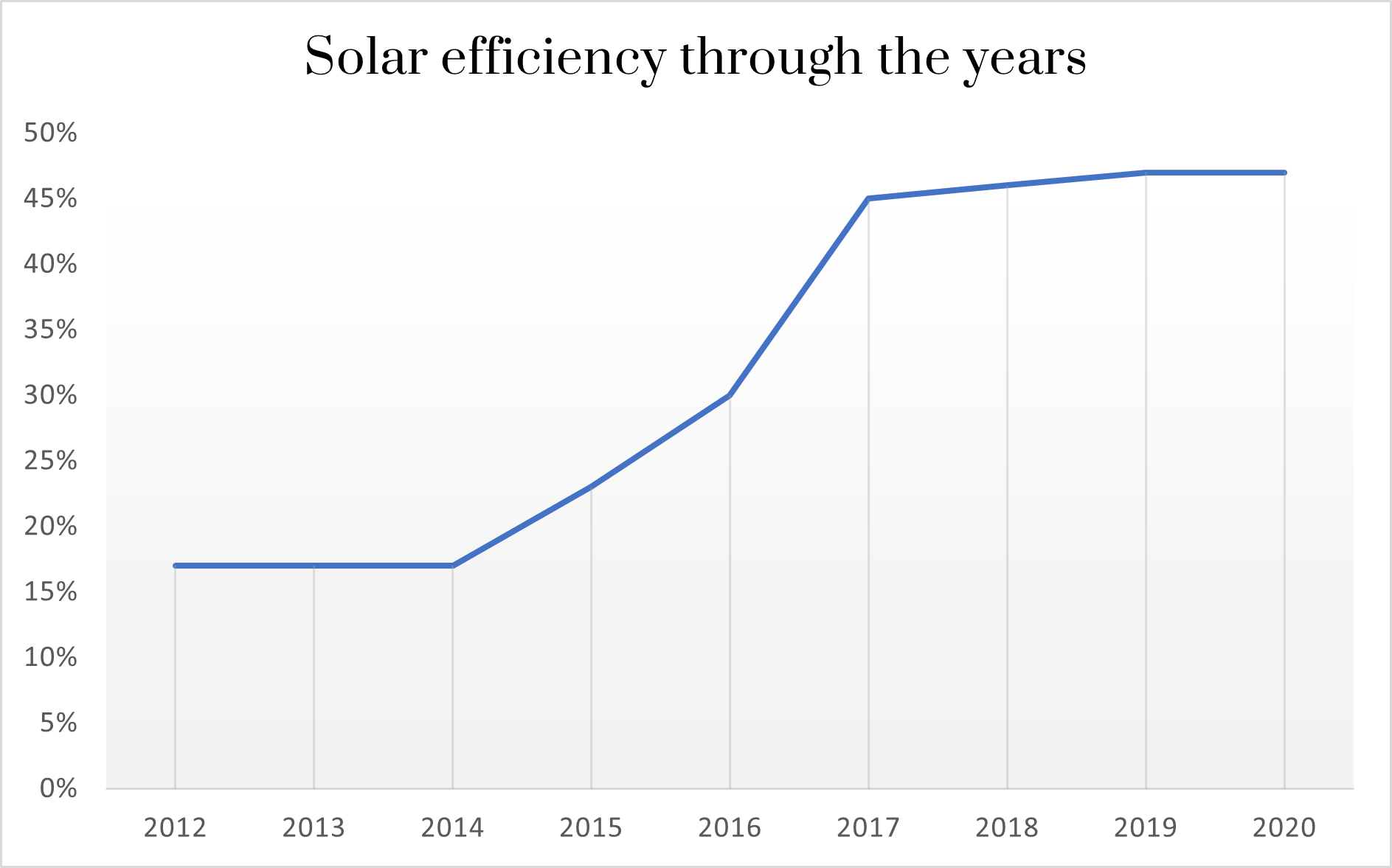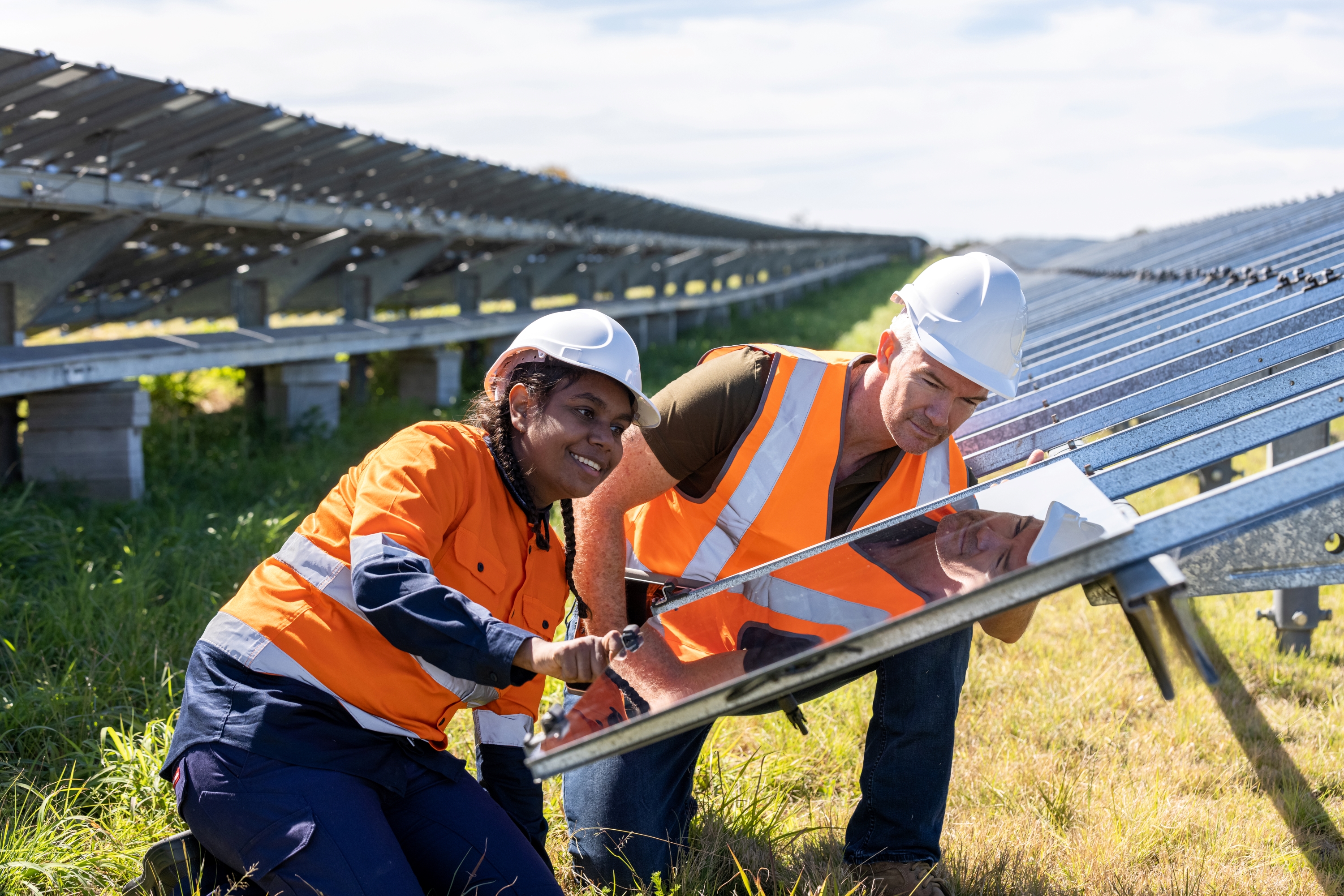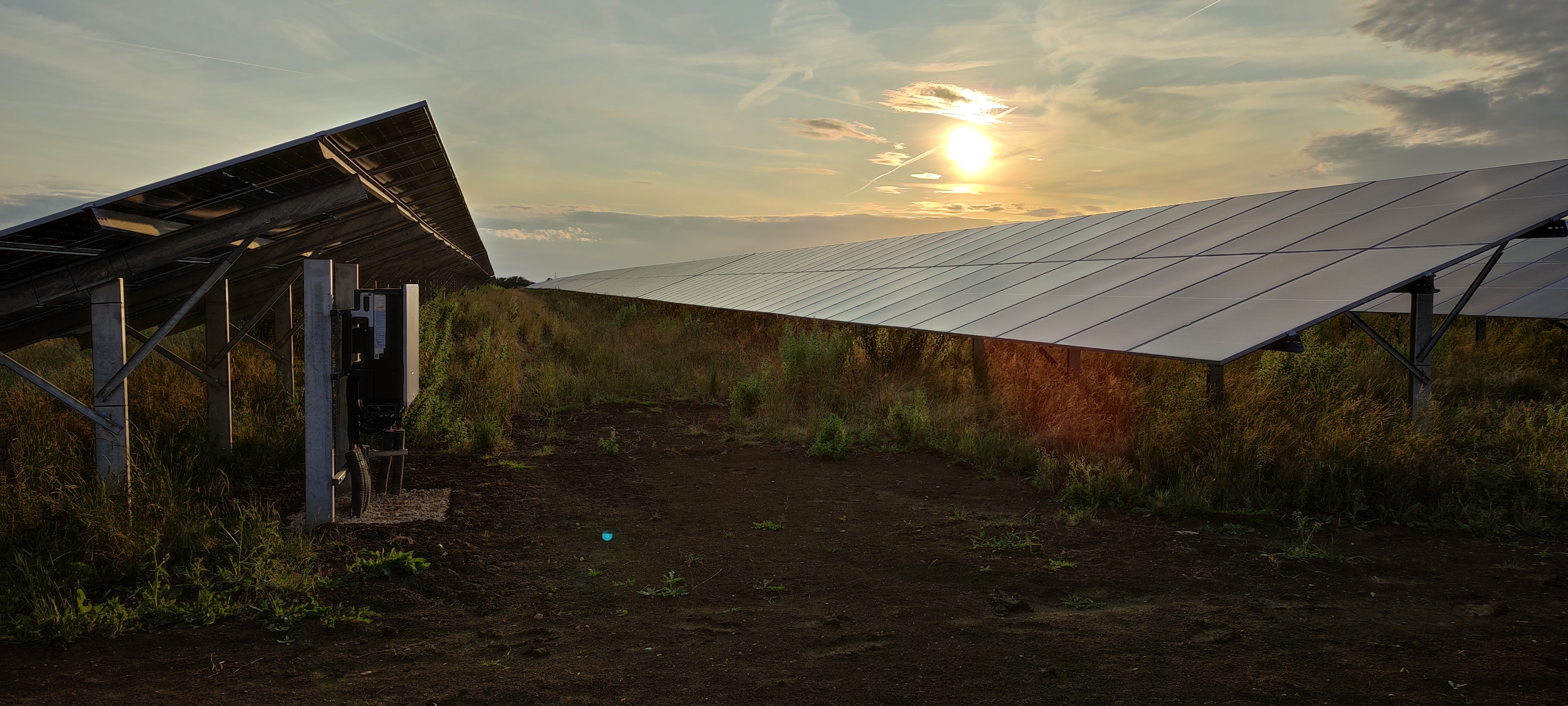Harnessing the power of the sun: A 101 on solar power technology


While the use of solar power to generate renewable energy is a fairly new phenomenon relative to wind and hydropower, the technology is already a key component of the global energy mix – and our dependence on it will only grow as we seek to move away from fossil fuels. In the following insight, we explore the evolution of solar power, its role in the global energy transition, and discuss why the technology should form a meaningful component of any diversified investment portfolio.
Dawn of a new technology
Humans have harnessed the sun’s power in various ways since the 7th century BCE. But the creation of solar photovoltaic (PV) power, as we know it today, is a relatively recent breakthrough.
After the ‘photovoltaic effect’ was first discovered by 19-year-old French scientist Edmond Becquerel in 1839, scientists around the world, including Albert Einstein, rallied to explore just how efficient a power source it could become. And by 1954 – when the potentially devastating effects of climate change began making headlines – the first ‘practical’ PV solar cell was developed.
In the decades since, the technology’s energy efficiency has grown exponentially. Solar-cell efficiency refers to the portion of energy in the form of sunlight that can be converted via photovoltaics into electricity by the solar cell. Since Hoffman Electric recorded 14% efficiency in 1960, the latest developments in 2020 by NREL achieved a solar cell with 47% efficiency. This rapid growth has led to an increase in affordability and adoption.
- 1960: Hoffman Electric achieves 14% efficiency in PV cells
- 1992: University of South Florida fabricates a 15.89% efficient thin-film cell
- 2012: Solar Frontier reaches 17.8% efficiency
- June 2015: First Solar breaks 18.2% efficiency
- October 2015: SolarCity announces 22.04% efficiency and Panasonic announces 22.5% efficiency
- November 2015: SunPower achieves 22.8% efficiency, validated by the National Renewable Energy Laboratory (NREL)
- January 2016: NREL and Swiss Center for Electronics and Microtechnology (CSEM) achieved 29.8% efficiency
- July 2017: A group of U.S. scientists develop a prototype for a solar cell capable of 44.5% efficiency
- April 2020: NREL researchers develop a six-junction III-V solar cell with 47.1% efficiency

Delivering a brighter future
Globally, solar power generation grew by a record 22% in 2021 to exceed 1000TWh, enough to power more than 340 million average British homes for a year. This meant solar PV represented one-third of renewables generation growth, with the technology now the third-largest renewable energy source behind hydropower and wind. The recent uptick in solar PV capacity is largely due to an acceleration of installations in China, Europe and the US, following several landmark policy support packages including the REPowerEU and the US Inflation Reduction Act.
However, even greater global adoption of PV will be necessary to achieve net zero and limit global temperature rises to 1.5°C. After all, the transition to net zero requires not only a shift to renewable sources, but also the ability to meet increasing electrical demand as the world electrifies highly carbon-intensive industries like construction, transport and heating. According to estimates, solar power generation must grow by about 25% a year until 2030 to meet the net zero emissions by 2050 commitment. This resembles a threefold increase in annual capacity deployment by the end of the decade.
Powering resilient returns
Although solar PV is already a robust source of returns for many investors, policymakers must continue to incentivise an even greater level of private investment into the technology to meet the gap in provision. Aside from its vast growth potential and supportive policy outlook, solar energy poses a compelling investment opportunity for several key reasons.
Economies of scale have driven the manufacturing cost of each panel down significantly over recent years – by about 93% between 2010 and 2020 – lowering costs for power producers and increasing demand from residential and commercial customers. As a result, the amount of capital required to deploy large solar facilities is decreasing. Lower capex on each project permits developers to build greater solar capacity, generate larger revenues, and thus deliver more attractive returns to investors.
Solar panels have an average lifespan of 25-30 years, with high-quality assets able to attain 40 years. This means solar investments can deliver highly stable and predictable cash flows over a lengthy time horizon.
In addition to supplying the energy grid, the opportunity to provide power directly to offtakers is growing. In August 2022, Downing was selected by Yorkshire Water to develop, design, build and operate a portfolio of 28 solar sites across Yorkshire. By generating a share of its power needs, these installations will help the national utility company with its goal of reaching net zero by 2030, while reducing the operational costs of its water supply and treatment sites.
Solar farms can also be effective in a much wider array of geographies than many people expect. For example, despite the popular view that the UK’s weather is mostly overcast, we have more than enough annual sunlight to power solar panels. As of September 2021, there were 1.1 million individual solar generators across the UK, equating to 13,587MW. To put this into perspective, when at full capacity, 1MW can power about 2000 British homes, or the equivalent of a small village. Other than expanding the total addressable market available to investors, the ability to diversify with solar assets across geographic regions helps mitigate the risks associated with local weather patterns and seasonality, giving a better chance of resilient returns.

Shining ESG credentials
Solar PV is also considered a robust investment in terms of ESG. Beyond the benefit for the planet of increasing solar power generation, to reduce the dependency on fossil fuels, solar technology’s positive impact on communities is often overlooked. Global renewable energy employment reached 12.7 million in 2021, with solar energy the fastest-growing sector at 4.3 million jobs – more than a third of the current renewables workforce. Moreover, given the scientific and technological know-how required to successfully manufacture, distribute, establish, and maintain solar power projects, many of these are highly skilled jobs in prosperous careers.
In addition, a growing amount of research is being carried out to ensure there are appropriate governance frameworks and guidelines in place to safeguard the surrounding environment and local communities from the impacts of solar projects. In the UK, a growing body of scientific evidence indicates that well-designed and managed solar projects can support wildlife habitats, while also contributing towards achieving national biodiversity targets.
Unlock the true potential of diversification
From a capital allocation perspective, investing in solar energy not only contributes to a greener global economy and brighter future for all, but it also offers attractive portfolio diversification potential. Utility-scale solar farms typically boast stable, predictable, long-term cashflows that are wholly or partly linked to inflation, while they also benefit from government regulations and concessions.
Nevertheless, to unlock the true diversification potential afforded by solar power assets, investors must champion a diversified portfolio of technologies. Most renewable power sources are highly dependent on weather conditions and seasonality, so exposure to multiple renewable infrastructure technologies – including wind, hydropower, and battery energy storage systems – can help deliver investors reliable returns.

While the use of solar power to generate renewable energy is a fairly new phenomenon relative to wind and hydropower, the technology is already a key component of the global energy mix – and our dependence on it will only grow as we seek to move away from fossil fuels. In the following insight, we explore the evolution of solar power, its role in the global energy transition, and discuss why the technology should form a meaningful component of any diversified investment portfolio.
Dawn of a new technology
Humans have harnessed the sun’s power in various ways since the 7th century BCE. But the creation of solar photovoltaic (PV) power, as we know it today, is a relatively recent breakthrough.
After the ‘photovoltaic effect’ was first discovered by 19-year-old French scientist Edmond Becquerel in 1839, scientists around the world, including Albert Einstein, rallied to explore just how efficient a power source it could become. And by 1954 – when the potentially devastating effects of climate change began making headlines – the first ‘practical’ PV solar cell was developed.
In the decades since, the technology’s energy efficiency has grown exponentially. Solar-cell efficiency refers to the portion of energy in the form of sunlight that can be converted via photovoltaics into electricity by the solar cell. Since Hoffman Electric recorded 14% efficiency in 1960, the latest developments in 2020 by NREL achieved a solar cell with 47% efficiency. This rapid growth has led to an increase in affordability and adoption.
- 1960: Hoffman Electric achieves 14% efficiency in PV cells
- 1992: University of South Florida fabricates a 15.89% efficient thin-film cell
- 2012: Solar Frontier reaches 17.8% efficiency
- June 2015: First Solar breaks 18.2% efficiency
- October 2015: SolarCity announces 22.04% efficiency and Panasonic announces 22.5% efficiency
- November 2015: SunPower achieves 22.8% efficiency, validated by the National Renewable Energy Laboratory (NREL)
- January 2016: NREL and Swiss Center for Electronics and Microtechnology (CSEM) achieved 29.8% efficiency
- July 2017: A group of U.S. scientists develop a prototype for a solar cell capable of 44.5% efficiency
- April 2020: NREL researchers develop a six-junction III-V solar cell with 47.1% efficiency

Delivering a brighter future
Globally, solar power generation grew by a record 22% in 2021 to exceed 1000TWh, enough to power more than 340 million average British homes for a year. This meant solar PV represented one-third of renewables generation growth, with the technology now the third-largest renewable energy source behind hydropower and wind. The recent uptick in solar PV capacity is largely due to an acceleration of installations in China, Europe and the US, following several landmark policy support packages including the REPowerEU and the US Inflation Reduction Act.
However, even greater global adoption of PV will be necessary to achieve net zero and limit global temperature rises to 1.5°C. After all, the transition to net zero requires not only a shift to renewable sources, but also the ability to meet increasing electrical demand as the world electrifies highly carbon-intensive industries like construction, transport and heating. According to estimates, solar power generation must grow by about 25% a year until 2030 to meet the net zero emissions by 2050 commitment. This resembles a threefold increase in annual capacity deployment by the end of the decade.
Powering resilient returns
Although solar PV is already a robust source of returns for many investors, policymakers must continue to incentivise an even greater level of private investment into the technology to meet the gap in provision. Aside from its vast growth potential and supportive policy outlook, solar energy poses a compelling investment opportunity for several key reasons.
Economies of scale have driven the manufacturing cost of each panel down significantly over recent years – by about 93% between 2010 and 2020 – lowering costs for power producers and increasing demand from residential and commercial customers. As a result, the amount of capital required to deploy large solar facilities is decreasing. Lower capex on each project permits developers to build greater solar capacity, generate larger revenues, and thus deliver more attractive returns to investors.
Solar panels have an average lifespan of 25-30 years, with high-quality assets able to attain 40 years. This means solar investments can deliver highly stable and predictable cash flows over a lengthy time horizon.
In addition to supplying the energy grid, the opportunity to provide power directly to offtakers is growing. In August 2022, Downing was selected by Yorkshire Water to develop, design, build and operate a portfolio of 28 solar sites across Yorkshire. By generating a share of its power needs, these installations will help the national utility company with its goal of reaching net zero by 2030, while reducing the operational costs of its water supply and treatment sites.
Solar farms can also be effective in a much wider array of geographies than many people expect. For example, despite the popular view that the UK’s weather is mostly overcast, we have more than enough annual sunlight to power solar panels. As of September 2021, there were 1.1 million individual solar generators across the UK, equating to 13,587MW. To put this into perspective, when at full capacity, 1MW can power about 2000 British homes, or the equivalent of a small village. Other than expanding the total addressable market available to investors, the ability to diversify with solar assets across geographic regions helps mitigate the risks associated with local weather patterns and seasonality, giving a better chance of resilient returns.

Shining ESG credentials
Solar PV is also considered a robust investment in terms of ESG. Beyond the benefit for the planet of increasing solar power generation, to reduce the dependency on fossil fuels, solar technology’s positive impact on communities is often overlooked. Global renewable energy employment reached 12.7 million in 2021, with solar energy the fastest-growing sector at 4.3 million jobs – more than a third of the current renewables workforce. Moreover, given the scientific and technological know-how required to successfully manufacture, distribute, establish, and maintain solar power projects, many of these are highly skilled jobs in prosperous careers.
In addition, a growing amount of research is being carried out to ensure there are appropriate governance frameworks and guidelines in place to safeguard the surrounding environment and local communities from the impacts of solar projects. In the UK, a growing body of scientific evidence indicates that well-designed and managed solar projects can support wildlife habitats, while also contributing towards achieving national biodiversity targets.
Unlock the true potential of diversification
From a capital allocation perspective, investing in solar energy not only contributes to a greener global economy and brighter future for all, but it also offers attractive portfolio diversification potential. Utility-scale solar farms typically boast stable, predictable, long-term cashflows that are wholly or partly linked to inflation, while they also benefit from government regulations and concessions.
Nevertheless, to unlock the true diversification potential afforded by solar power assets, investors must champion a diversified portfolio of technologies. Most renewable power sources are highly dependent on weather conditions and seasonality, so exposure to multiple renewable infrastructure technologies – including wind, hydropower, and battery energy storage systems – can help deliver investors reliable returns.

While the use of solar power to generate renewable energy is a fairly new phenomenon relative to wind and hydropower, the technology is already a key component of the global energy mix – and our dependence on it will only grow as we seek to move away from fossil fuels. In the following insight, we explore the evolution of solar power, its role in the global energy transition, and discuss why the technology should form a meaningful component of any diversified investment portfolio.
Dawn of a new technology
Humans have harnessed the sun’s power in various ways since the 7th century BCE. But the creation of solar photovoltaic (PV) power, as we know it today, is a relatively recent breakthrough.
After the ‘photovoltaic effect’ was first discovered by 19-year-old French scientist Edmond Becquerel in 1839, scientists around the world, including Albert Einstein, rallied to explore just how efficient a power source it could become. And by 1954 – when the potentially devastating effects of climate change began making headlines – the first ‘practical’ PV solar cell was developed.
In the decades since, the technology’s energy efficiency has grown exponentially. Solar-cell efficiency refers to the portion of energy in the form of sunlight that can be converted via photovoltaics into electricity by the solar cell. Since Hoffman Electric recorded 14% efficiency in 1960, the latest developments in 2020 by NREL achieved a solar cell with 47% efficiency. This rapid growth has led to an increase in affordability and adoption.
- 1960: Hoffman Electric achieves 14% efficiency in PV cells
- 1992: University of South Florida fabricates a 15.89% efficient thin-film cell
- 2012: Solar Frontier reaches 17.8% efficiency
- June 2015: First Solar breaks 18.2% efficiency
- October 2015: SolarCity announces 22.04% efficiency and Panasonic announces 22.5% efficiency
- November 2015: SunPower achieves 22.8% efficiency, validated by the National Renewable Energy Laboratory (NREL)
- January 2016: NREL and Swiss Center for Electronics and Microtechnology (CSEM) achieved 29.8% efficiency
- July 2017: A group of U.S. scientists develop a prototype for a solar cell capable of 44.5% efficiency
- April 2020: NREL researchers develop a six-junction III-V solar cell with 47.1% efficiency

Delivering a brighter future
Globally, solar power generation grew by a record 22% in 2021 to exceed 1000TWh, enough to power more than 340 million average British homes for a year. This meant solar PV represented one-third of renewables generation growth, with the technology now the third-largest renewable energy source behind hydropower and wind. The recent uptick in solar PV capacity is largely due to an acceleration of installations in China, Europe and the US, following several landmark policy support packages including the REPowerEU and the US Inflation Reduction Act.
However, even greater global adoption of PV will be necessary to achieve net zero and limit global temperature rises to 1.5°C. After all, the transition to net zero requires not only a shift to renewable sources, but also the ability to meet increasing electrical demand as the world electrifies highly carbon-intensive industries like construction, transport and heating. According to estimates, solar power generation must grow by about 25% a year until 2030 to meet the net zero emissions by 2050 commitment. This resembles a threefold increase in annual capacity deployment by the end of the decade.
Powering resilient returns
Although solar PV is already a robust source of returns for many investors, policymakers must continue to incentivise an even greater level of private investment into the technology to meet the gap in provision. Aside from its vast growth potential and supportive policy outlook, solar energy poses a compelling investment opportunity for several key reasons.
Economies of scale have driven the manufacturing cost of each panel down significantly over recent years – by about 93% between 2010 and 2020 – lowering costs for power producers and increasing demand from residential and commercial customers. As a result, the amount of capital required to deploy large solar facilities is decreasing. Lower capex on each project permits developers to build greater solar capacity, generate larger revenues, and thus deliver more attractive returns to investors.
Solar panels have an average lifespan of 25-30 years, with high-quality assets able to attain 40 years. This means solar investments can deliver highly stable and predictable cash flows over a lengthy time horizon.
In addition to supplying the energy grid, the opportunity to provide power directly to offtakers is growing. In August 2022, Downing was selected by Yorkshire Water to develop, design, build and operate a portfolio of 28 solar sites across Yorkshire. By generating a share of its power needs, these installations will help the national utility company with its goal of reaching net zero by 2030, while reducing the operational costs of its water supply and treatment sites.
Solar farms can also be effective in a much wider array of geographies than many people expect. For example, despite the popular view that the UK’s weather is mostly overcast, we have more than enough annual sunlight to power solar panels. As of September 2021, there were 1.1 million individual solar generators across the UK, equating to 13,587MW. To put this into perspective, when at full capacity, 1MW can power about 2000 British homes, or the equivalent of a small village. Other than expanding the total addressable market available to investors, the ability to diversify with solar assets across geographic regions helps mitigate the risks associated with local weather patterns and seasonality, giving a better chance of resilient returns.

Shining ESG credentials
Solar PV is also considered a robust investment in terms of ESG. Beyond the benefit for the planet of increasing solar power generation, to reduce the dependency on fossil fuels, solar technology’s positive impact on communities is often overlooked. Global renewable energy employment reached 12.7 million in 2021, with solar energy the fastest-growing sector at 4.3 million jobs – more than a third of the current renewables workforce. Moreover, given the scientific and technological know-how required to successfully manufacture, distribute, establish, and maintain solar power projects, many of these are highly skilled jobs in prosperous careers.
In addition, a growing amount of research is being carried out to ensure there are appropriate governance frameworks and guidelines in place to safeguard the surrounding environment and local communities from the impacts of solar projects. In the UK, a growing body of scientific evidence indicates that well-designed and managed solar projects can support wildlife habitats, while also contributing towards achieving national biodiversity targets.
Unlock the true potential of diversification
From a capital allocation perspective, investing in solar energy not only contributes to a greener global economy and brighter future for all, but it also offers attractive portfolio diversification potential. Utility-scale solar farms typically boast stable, predictable, long-term cashflows that are wholly or partly linked to inflation, while they also benefit from government regulations and concessions.
Nevertheless, to unlock the true diversification potential afforded by solar power assets, investors must champion a diversified portfolio of technologies. Most renewable power sources are highly dependent on weather conditions and seasonality, so exposure to multiple renewable infrastructure technologies – including wind, hydropower, and battery energy storage systems – can help deliver investors reliable returns.

While the use of solar power to generate renewable energy is a fairly new phenomenon relative to wind and hydropower, the technology is already a key component of the global energy mix – and our dependence on it will only grow as we seek to move away from fossil fuels. In the following insight, we explore the evolution of solar power, its role in the global energy transition, and discuss why the technology should form a meaningful component of any diversified investment portfolio.
Dawn of a new technology
Humans have harnessed the sun’s power in various ways since the 7th century BCE. But the creation of solar photovoltaic (PV) power, as we know it today, is a relatively recent breakthrough.
After the ‘photovoltaic effect’ was first discovered by 19-year-old French scientist Edmond Becquerel in 1839, scientists around the world, including Albert Einstein, rallied to explore just how efficient a power source it could become. And by 1954 – when the potentially devastating effects of climate change began making headlines – the first ‘practical’ PV solar cell was developed.
In the decades since, the technology’s energy efficiency has grown exponentially. Solar-cell efficiency refers to the portion of energy in the form of sunlight that can be converted via photovoltaics into electricity by the solar cell. Since Hoffman Electric recorded 14% efficiency in 1960, the latest developments in 2020 by NREL achieved a solar cell with 47% efficiency. This rapid growth has led to an increase in affordability and adoption.
- 1960: Hoffman Electric achieves 14% efficiency in PV cells
- 1992: University of South Florida fabricates a 15.89% efficient thin-film cell
- 2012: Solar Frontier reaches 17.8% efficiency
- June 2015: First Solar breaks 18.2% efficiency
- October 2015: SolarCity announces 22.04% efficiency and Panasonic announces 22.5% efficiency
- November 2015: SunPower achieves 22.8% efficiency, validated by the National Renewable Energy Laboratory (NREL)
- January 2016: NREL and Swiss Center for Electronics and Microtechnology (CSEM) achieved 29.8% efficiency
- July 2017: A group of U.S. scientists develop a prototype for a solar cell capable of 44.5% efficiency
- April 2020: NREL researchers develop a six-junction III-V solar cell with 47.1% efficiency

Delivering a brighter future
Globally, solar power generation grew by a record 22% in 2021 to exceed 1000TWh, enough to power more than 340 million average British homes for a year. This meant solar PV represented one-third of renewables generation growth, with the technology now the third-largest renewable energy source behind hydropower and wind. The recent uptick in solar PV capacity is largely due to an acceleration of installations in China, Europe and the US, following several landmark policy support packages including the REPowerEU and the US Inflation Reduction Act.
However, even greater global adoption of PV will be necessary to achieve net zero and limit global temperature rises to 1.5°C. After all, the transition to net zero requires not only a shift to renewable sources, but also the ability to meet increasing electrical demand as the world electrifies highly carbon-intensive industries like construction, transport and heating. According to estimates, solar power generation must grow by about 25% a year until 2030 to meet the net zero emissions by 2050 commitment. This resembles a threefold increase in annual capacity deployment by the end of the decade.
Powering resilient returns
Although solar PV is already a robust source of returns for many investors, policymakers must continue to incentivise an even greater level of private investment into the technology to meet the gap in provision. Aside from its vast growth potential and supportive policy outlook, solar energy poses a compelling investment opportunity for several key reasons.
Economies of scale have driven the manufacturing cost of each panel down significantly over recent years – by about 93% between 2010 and 2020 – lowering costs for power producers and increasing demand from residential and commercial customers. As a result, the amount of capital required to deploy large solar facilities is decreasing. Lower capex on each project permits developers to build greater solar capacity, generate larger revenues, and thus deliver more attractive returns to investors.
Solar panels have an average lifespan of 25-30 years, with high-quality assets able to attain 40 years. This means solar investments can deliver highly stable and predictable cash flows over a lengthy time horizon.
In addition to supplying the energy grid, the opportunity to provide power directly to offtakers is growing. In August 2022, Downing was selected by Yorkshire Water to develop, design, build and operate a portfolio of 28 solar sites across Yorkshire. By generating a share of its power needs, these installations will help the national utility company with its goal of reaching net zero by 2030, while reducing the operational costs of its water supply and treatment sites.
Solar farms can also be effective in a much wider array of geographies than many people expect. For example, despite the popular view that the UK’s weather is mostly overcast, we have more than enough annual sunlight to power solar panels. As of September 2021, there were 1.1 million individual solar generators across the UK, equating to 13,587MW. To put this into perspective, when at full capacity, 1MW can power about 2000 British homes, or the equivalent of a small village. Other than expanding the total addressable market available to investors, the ability to diversify with solar assets across geographic regions helps mitigate the risks associated with local weather patterns and seasonality, giving a better chance of resilient returns.

Shining ESG credentials
Solar PV is also considered a robust investment in terms of ESG. Beyond the benefit for the planet of increasing solar power generation, to reduce the dependency on fossil fuels, solar technology’s positive impact on communities is often overlooked. Global renewable energy employment reached 12.7 million in 2021, with solar energy the fastest-growing sector at 4.3 million jobs – more than a third of the current renewables workforce. Moreover, given the scientific and technological know-how required to successfully manufacture, distribute, establish, and maintain solar power projects, many of these are highly skilled jobs in prosperous careers.
In addition, a growing amount of research is being carried out to ensure there are appropriate governance frameworks and guidelines in place to safeguard the surrounding environment and local communities from the impacts of solar projects. In the UK, a growing body of scientific evidence indicates that well-designed and managed solar projects can support wildlife habitats, while also contributing towards achieving national biodiversity targets.
Unlock the true potential of diversification
From a capital allocation perspective, investing in solar energy not only contributes to a greener global economy and brighter future for all, but it also offers attractive portfolio diversification potential. Utility-scale solar farms typically boast stable, predictable, long-term cashflows that are wholly or partly linked to inflation, while they also benefit from government regulations and concessions.
Nevertheless, to unlock the true diversification potential afforded by solar power assets, investors must champion a diversified portfolio of technologies. Most renewable power sources are highly dependent on weather conditions and seasonality, so exposure to multiple renewable infrastructure technologies – including wind, hydropower, and battery energy storage systems – can help deliver investors reliable returns.

Please fill out the form to download the full report
Downing LLP does not provide advice or make personal recommendations and investors are strongly urged to seek independent advice before investing. Investments offered on this website carry a higher risk than many other types of investment and prospective investors should be aware that capital is at risk and the value of their investment may go down as well as up. Any investment should only be made on the basis of the relevant product literature and your attention is drawn to the risk, fees and taxation factors contained therein. Tax treatment depends on individual circumstances of each investor and may be subject to change in the future. Past performance is not a reliable indicator of future performance. Downing LLP is authorised and regulated by the Financial Conduct Authority (Firm Reference Number 545025). Registered in England No. OC341575. Registered Office: Downing, 10 Lower Thames Street, London, EC3R 6AF.









